It looks like you're using an Ad Blocker.
Please white-list or disable AboveTopSecret.com in your ad-blocking tool.
Thank you.
Some features of ATS will be disabled while you continue to use an ad-blocker.
share:
(37-of-76) COVERT ACTION QUARTERLY & the Holocaust(s) … see 1-of-76 for legend & relevance to Holocaust denial
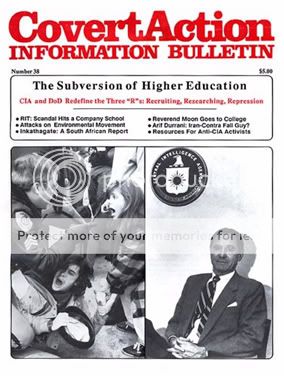
Number 38 (1991) DoD-CIA foreign/U.S. student recruitment; Rochester Institute of Technology; Harvard; Militarism in academia resources; Judi Bari; Arif Durrani; Rev. Moon and academia; Targeting environmentalists; CIABase review.

Number 38 (1991) DoD-CIA foreign/U.S. student recruitment; Rochester Institute of Technology; Harvard; Militarism in academia resources; Judi Bari; Arif Durrani; Rev. Moon and academia; Targeting environmentalists; CIABase review.
38-of-76) COVERT ACTION QUARTERLY & the Holocaust(s) … see 1-of-76 for legend & relevance to Holocaust denial

Number 39 (1991-92) “Good” agencies: NED; Peace Corps; USAID/AIDS; USIA; National Cancer Institute/biowarfare; World Bank; Population control; Danny Casolaro; FBI & Supreme Court; Robert Gates; USSR destabilization; BCCI.
THIS IS ANOTHER MUST-READ for CBW, the destabilization of Soviet Union and Eastern Europe, and BCCI forces embodied by Saudi Arabia, Britain, Germany and the U.S.

Number 39 (1991-92) “Good” agencies: NED; Peace Corps; USAID/AIDS; USIA; National Cancer Institute/biowarfare; World Bank; Population control; Danny Casolaro; FBI & Supreme Court; Robert Gates; USSR destabilization; BCCI.
THIS IS ANOTHER MUST-READ for CBW, the destabilization of Soviet Union and Eastern Europe, and BCCI forces embodied by Saudi Arabia, Britain, Germany and the U.S.
(39-of-76) COVERT ACTION QUARTERLY & the Holocaust(s) … see 1-of-76 for legend & relevance to Holocaust denial
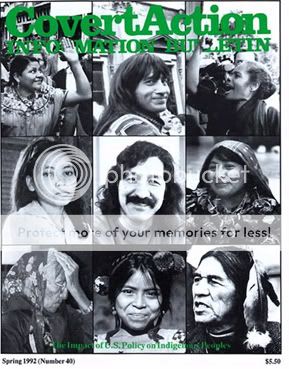
Number 40 (1992) Native American struggle history; Toxic dumps; Leonard Peltier; Hollywood’s racism; Guatemala; Rigoberta Menchu interview; Pol Pot returns; East Timor massacre; U.S. in Pacific, GATT; David Duke in India.
David Duke in India?????

Number 40 (1992) Native American struggle history; Toxic dumps; Leonard Peltier; Hollywood’s racism; Guatemala; Rigoberta Menchu interview; Pol Pot returns; East Timor massacre; U.S. in Pacific, GATT; David Duke in India.
David Duke in India?????
(40-of-76) COVERT ACTION QUARTERLY & the Holocaust(s) … see 1-of-76 for legend & relevance to Holocaust denial
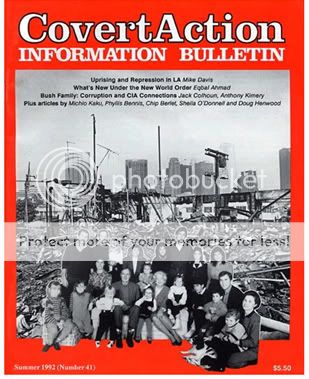
Number 41 (1992) Special-Next Enemies- LA Uprising; Geo. Bush and CIA; Bush Family; Eqbal Ahmad; UN: U.S. Tool; Nuclear Proliferation; Environmentalist Attacked; U.S. Economic Decline; Dissent as Subversion.
Didn't know there were so many of them, did you? They're all aiming for us and future generations, make no mistake about it.
The article on the above Bush Family link mediafilter.org... has messed-up formatting in 3-word-long sentences, so here it is in readable form, at www.my2012.4t.com .
[edit on 5-5-2008 by counterterrorist]

Number 41 (1992) Special-Next Enemies- LA Uprising; Geo. Bush and CIA; Bush Family; Eqbal Ahmad; UN: U.S. Tool; Nuclear Proliferation; Environmentalist Attacked; U.S. Economic Decline; Dissent as Subversion.
Didn't know there were so many of them, did you? They're all aiming for us and future generations, make no mistake about it.
The article on the above Bush Family link mediafilter.org... has messed-up formatting in 3-word-long sentences, so here it is in readable form, at www.my2012.4t.com .
The Family That Preys Together by Jack Colhoun
From Covert Action Quarterly, Issue No. 41, Summer, 1992
GEORGE JR.'S BCCI CONNECTION "This is an incredible deal, unbelievable for this small company," energy analyst Charles Strain told Forbes magazine, describing the oil production sharing agreement the Harken Energy Corporation signed in January 1990 with Bahrain.
Under the terms of the deal, Harken was given the exclusive right to explore for gas and oil off the shores of the Gulf island nation. If gas or oil were found in waters near two of the world's largest gas and oil fields, Harken would have exclusive marketing and transportation rights for the energy resources. Truly an "incredible deal" for a company that had never drilled an offshore well.
Strain failed to point out, however, the one fact that puts the Harken deal in focus: George Bush, Jr., the eldest son of George and Barbara Bush of 1600 Pennsylvania Avenue, Washington, DC, is a member of Harken's board of directors, a consultant, and a stockholder in the Texas-based company. In light of this connection, the deal makes more sense. The involvement of Junior-George Walker Bush's childhood nickname-with Harken is a walking conflict of interest. His relationship to President Bush, rather than any business acumen, made him a valuable asset for Harken, the Republican Party benefactors, Middle East oil sheikhs and covert operators who played a part in Harken's Bahrain deal.
Meanwhile, a cloak-and-dagger aura surrounds Junior's business dealings. James Bath, a Texas entrepreneur who invested $50,000 in Arbusto Energy, may be a business cutout for the CIA. Bath also acted as an investment "adviser" to Saudi Arabian oil sheikhs, linked to the outlaw BCCI, which also has ties to the CIA. Bill White, a former Bath partner, claims that Bath has "national security" connections. White, a United States Naval Academy graduate and former fighter pilot, charges that Bath developed a network of off-shore companies to camouflage the movement of money and aircraft between Texas and the Middle East, especially Saudi Arabia.
Alan Quasha, a Harken director and former chair of the company, is the son of attorney William Quasha, who defended figures in the Nugan Hand Bank scandal in Australia. Closed in 1980, Nugan Hand was not only tied to drug-money laundering and U.S. intelligence and mi- litary circles, but also to the CIA's covert backing for a "constitutional coup" in Australia that caused the fall of Prime Minister Gough Whitlam.
GEORGE BUSH: The Super-Spy Druq-Smuqqlinq President
By Bill Weinberg
A well-researched history of George Bush and his family includes: Where Was George Bush on November 22, 1963?; Global Power Broker; CIA Man; October Surprise; Contragate; Panamagate; Hinckleygate and Other Mysteries; Nazigate; The New World Order; Afghanigate; The BCCI Octopus; Quaylegate; Kuwaitgate; Was "Desert Storm" Smoke and Mirrors?
[edit on 5-5-2008 by counterterrorist]
(41-of-76) COVERT ACTION QUARTERLY & the Holocaust(s) … see 1-of-76 for legend & relevance to Holocaust denial

42 ( 1992) Agee on Covert Ops; Peru; Fluonde; VP Bush and CIA; Nicaragua; SO/LIC; Militarizing the Drug War; CIA Targets Gonzalez; Bush Inaugural Leak; Rev. Moon Buys University.
Agee on Covert Ops the following url is messed up mediafilter.org...
So, use this url, which is reformatted www.my2012.4t.com
Here are a few excerpts:
[ex assure that American transnationals get their hot hands, in the race against Germany, on the resource-richest land mass on the globe.

42 ( 1992) Agee on Covert Ops; Peru; Fluonde; VP Bush and CIA; Nicaragua; SO/LIC; Militarizing the Drug War; CIA Targets Gonzalez; Bush Inaugural Leak; Rev. Moon Buys University.
Agee on Covert Ops the following url is messed up mediafilter.org...
So, use this url, which is reformatted www.my2012.4t.com
Here are a few excerpts:
My role was to outline U.S. efforts during the Cold War- mainly through the CIA-to suppress Third World national liberation movements.
The events in L.A. and other cities underlined the domestic system that produces, and is in turn affected by, U.S. foreign policy, including CIA activities. They were also a vivid reminder that the 1990s is a period of transition, with enormous opportunities for change in national priorities-a potential not seen since the late 1940s.
In the process the CIA's covert operations, already in progress in Europe, expanded worldwide. By 1953, according to the 1970s Senate investigation, there were major covert programs under way in 48 countries, consisting of propaganda, paramilitary, and political action operations.
[ex assure that American transnationals get their hot hands, in the race against Germany, on the resource-richest land mass on the globe.
militarism and world domination continue to be the main national priority, with covert operations playing an integral role. Everyone knows that as long as this continues, there will be no solutions to domestic troubles, and the U.S. will continue to decline while growing more separate and unequal. [/ex
(42-of-76) COVERT ACTION QUARTERLY & the Holocaust(s) … see 1-of-76 for legend & relevance to Holocaust denial
Number 43 (1992-93) Chemical and biological warfare: Zimbabwe, South Africa, anthrax; Gulf War Syndrome; Agent Orange; Scientific racism; “Yellow Rain”/Wall Street Journal; Yugoslavia destabilization; Religious Right; Somalia.
Number 43 (1992-93) Chemical and biological warfare: Zimbabwe, South Africa, anthrax; Gulf War Syndrome; Agent Orange; Scientific racism; “Yellow Rain”/Wall Street Journal; Yugoslavia destabilization; Religious Right; Somalia.
(43-of-76) COVERT ACTION QUARTERLY & the Holocaust(s) … see 1-of-76 for legend & relevance to Holocaust denial
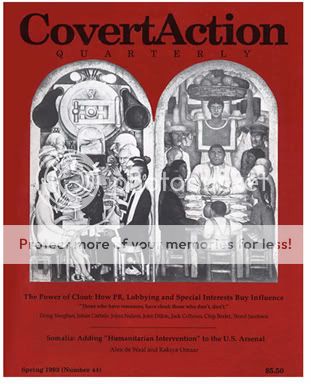
Number 44 (Sprlng 1993) Special-Public relations, buying influence, Hill & Knowlton, Burson-Marsteller, Clinton Cabinet; Somalia:"humanitarian" intervention, Rio Summit Greenwash, BCCI-CIA; Clinton & Nat. Sec. Act; Anti-Gay plans.
THIS IS ALSO A MUST-READ, IT DOCUMENTS THE PUBLIC RELATIONS OUTFITS doing their SOCIAL ENGINEERING (propaganda/mind control).
Hill & Knowlton, mediafilter.org...&Knowlton.html

Number 44 (Sprlng 1993) Special-Public relations, buying influence, Hill & Knowlton, Burson-Marsteller, Clinton Cabinet; Somalia:"humanitarian" intervention, Rio Summit Greenwash, BCCI-CIA; Clinton & Nat. Sec. Act; Anti-Gay plans.
THIS IS ALSO A MUST-READ, IT DOCUMENTS THE PUBLIC RELATIONS OUTFITS doing their SOCIAL ENGINEERING (propaganda/mind control).
Hill & Knowlton, mediafilter.org...&Knowlton.html
Hill & Knowlton, Robert Gray,
and the CIA ---
by Johan Carlisle from the Spring 1993 issue of CAQ (Number44)
Public relations and lobbying firms are part of the revolving door between government and business that President Clinton has vowed to close. It is not clear how he will accomplish this goal when so many of his top appointees, including Ron Brown and Howard Paster, are "business as usual" Washington insiders. Ron Brown, who was a lobbyist and attorney for Haiti's "BabyDoc"Duvalier, is Clinton's Secretary of Commerce. Paster, former head of Hill and Knowlton 's Washington office, directed the confirmation process during the transition period and is now Director of Intergovernmental Affairs for the White House. After managing PR for the Gulf War, Hill and Knowlton executive Lauri J. Fitz-Pegado became director of public liaison for the inauguration.
The door swings both ways. Thomas Hoog, who served on Clinton's transition team, has replaced Paster as head of H&K's Washington office.
Hill and Knowlton is one of the world 's largest and most influential corporations. As such, its virtually unregulated status, its longstanding connections to intelligence agencies, its role in shaping policy, and its close relationship to the Clinton administration deserve careful scrutiny.
In Turkey, "in July 1991, the same month President George Bush made an official visit there, the body of human rights worker Vedat Aydin was found along a road. His skull was fractured, his legs were broken, and his body was riddled by more than a dozen bullet wounds. He had been taken from his home by several armed men who identified themselves as police officers. No one was charged with his murder." De- spite hundreds of such "credible reports" acknowledged by the State Department, documenting use of "high-pressure cold water hoses, electric shocks, beating of the genitalia, and hanging by the arms," Turkey reaps the benefits of U.S. friendship and Most Favored Nation status. "Last year Turkey received more than $800 million in U.S. aid, and spent more than $3.8 million on Washington lobbyists to keep that money flowing." Turkey paid for U.S. tolerance of torture with its cooperative role in NATO, and its support for Operation Desert Storm; it bought its relatively benign public image with cold cash. Turkey's favorite Washington public relations and lobbying firm is Hill and Knowlton (H&K), to which it paid $1,200,000 from November 1990 to May 1992. Other chronic human rights abusers, such as China, Peru, Israel, Egypt, and Indonesia, also retained Hill and Knowlton to the tune of $14 million in 1991-92. Hill and Knowlton has also represented the infamously repressive Duvalier regime in Haiti.
(43-of-76) COVERT ACTION QUARTERLY & the Holocaust(s) … see 1-of-76 for legend & relevance to Holocaust denial

Number 44 (Sprlng 1993) Special-Public relations, buying influence, Hill & Knowlton, Burson-Marsteller, Clinton Cabinet; Somalia:"humanitarian" intervention, Rio Summit Greenwash, BCCI-CIA; Clinton & Nat. Sec. Act; Anti-Gay plans.
THIS IS ALSO A MUST-READ, IT DOCUMENTS THE PUBLIC RELATIONS OUTFITS doing their SOCIAL ENGINEERING (propaganda/mind control).
Hill & Knowlton, mediafilter.org...&Knowlton.html
[edit on 5-5-2008 by counterterrorist]

Number 44 (Sprlng 1993) Special-Public relations, buying influence, Hill & Knowlton, Burson-Marsteller, Clinton Cabinet; Somalia:"humanitarian" intervention, Rio Summit Greenwash, BCCI-CIA; Clinton & Nat. Sec. Act; Anti-Gay plans.
THIS IS ALSO A MUST-READ, IT DOCUMENTS THE PUBLIC RELATIONS OUTFITS doing their SOCIAL ENGINEERING (propaganda/mind control).
Hill & Knowlton, mediafilter.org...&Knowlton.html
Hill & Knowlton, Robert Gray,
and the CIA ---
by Johan Carlisle from the Spring 1993 issue of CAQ (Number44)
Public relations and lobbying firms are part of the revolving door between government and business that President Clinton has vowed to close. It is not clear how he will accomplish this goal when so many of his top appointees, including Ron Brown and Howard Paster, are "business as usual" Washington insiders. Ron Brown, who was a lobbyist and attorney for Haiti's "BabyDoc"Duvalier, is Clinton's Secretary of Commerce. Paster, former head of Hill and Knowlton 's Washington office, directed the confirmation process during the transition period and is now Director of Intergovernmental Affairs for the White House. After managing PR for the Gulf War, Hill and Knowlton executive Lauri J. Fitz-Pegado became director of public liaison for the inauguration.
The door swings both ways. Thomas Hoog, who served on Clinton's transition team, has replaced Paster as head of H&K's Washington office.
Hill and Knowlton is one of the world 's largest and most influential corporations. As such, its virtually unregulated status, its longstanding connections to intelligence agencies, its role in shaping policy, and its close relationship to the Clinton administration deserve careful scrutiny.
In Turkey, "in July 1991, the same month President George Bush made an official visit there, the body of human rights worker Vedat Aydin was found along a road. His skull was fractured, his legs were broken, and his body was riddled by more than a dozen bullet wounds. He had been taken from his home by several armed men who identified themselves as police officers. No one was charged with his murder." De- spite hundreds of such "credible reports" acknowledged by the State Department, documenting use of "high-pressure cold water hoses, electric shocks, beating of the genitalia, and hanging by the arms," Turkey reaps the benefits of U.S. friendship and Most Favored Nation status. "Last year Turkey received more than $800 million in U.S. aid, and spent more than $3.8 million on Washington lobbyists to keep that money flowing." Turkey paid for U.S. tolerance of torture with its cooperative role in NATO, and its support for Operation Desert Storm; it bought its relatively benign public image with cold cash. Turkey's favorite Washington public relations and lobbying firm is Hill and Knowlton (H&K), to which it paid $1,200,000 from November 1990 to May 1992. Other chronic human rights abusers, such as China, Peru, Israel, Egypt, and Indonesia, also retained Hill and Knowlton to the tune of $14 million in 1991-92. Hill and Knowlton has also represented the infamously repressive Duvalier regime in Haiti.
[edit on 5-5-2008 by counterterrorist]
(44-of-76) COVERT ACTION QUARTERLY & the Holocaust(s) … see 1-of-76 for legend & relevance to Holocaust denial
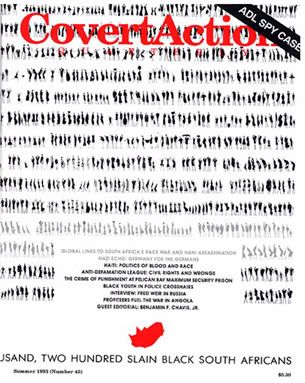
Number 45 (1993) South African Right global links; Chris Hani assassination; German Neo-Nazis; HIV Haitians; Russia; ADL spying list; Pelican Bay prison; Ireland’s youth; Police vs. black youth; Angola profiteers; Benjamin Chavis.
Misc post regarding Mae Brussells & the Bormann neo-nazi conspiracy:
… on Bolschwing, Maxala, Peron, Skorzeny, Warner-Lambert, Sullivan & Cromwell, Dulles, Odessa
Mae Brussell’s, Nazi Connections to JFK, in Rebel, about Otto von Bolschwing.
[edit on 5-5-2008 by counterterrorist]

Number 45 (1993) South African Right global links; Chris Hani assassination; German Neo-Nazis; HIV Haitians; Russia; ADL spying list; Pelican Bay prison; Ireland’s youth; Police vs. black youth; Angola profiteers; Benjamin Chavis.
Misc post regarding Mae Brussells & the Bormann neo-nazi conspiracy:
Nazis and neo-Nazis.
When Malaxa went to Argentina in 1952, he linked up with Juan Peron and Otto Skorzeny
… on Bolschwing, Maxala, Peron, Skorzeny, Warner-Lambert, Sullivan & Cromwell, Dulles, Odessa
Mae Brussell’s, Nazi Connections to JFK, in Rebel, about Otto von Bolschwing.
Otto Albrecht von Bolschwing was a captain in Heinrich Himmler’s dreaded SS, and was Adolph Eichmann’s superior in Europe and Palestine. Von Bolschwing worked simultaneously for Dulles’ OSS. When he entered U.S. in Feb. 1954, he concealed his Nazi past. He was to take over Gehlen’s network in this country, and in many corners of the globe. He became closely associated with the late Elmer Bobst of Warner-Lambert Pharmaceutical, a godfather of Richard Nixon’s political career, which brought him inside Nixon’s 1960 campaign for the Presidency.
In 1969, he showed up in California with a high-tech firm, TCI, that held classified Defense Department contracts. Trifia was brought to U.S. by von Bolschwing. Malaxa had escaped from Europe with 200 million dollars, in U.S. dollars. On arrival in New York, he picked up another 200 million dollars from Chase Manhattan Bank. The legal path for his entry was smoothed by Sullivan & Cromwell law offices, Dulles brothers’ firm. Undersecretary of State Adolph Berle personally testified on Malaxa’s behalf before a congressional subcommittee.
In 1951, Senator Nixon introduced a private bill to allow Malaxa permanent residence. Arrangements for relocation in Whittier were made by Nixon’s law office. The dummy front cover for Malaxa in Whittier was Western Tube. In 1946, Nixon got a call from Herman L. Perry asking if he wanted to run for Congress against Rep. Jerry Voorhis. Perry later became president of Western Tube. In 1952, Nicolae Malaxa moved from Whittier California to Argentina. Malaxa had belonged to Otto von Bolschwing’s Gestapo network, as did his associate, Viorel Trifia, living in Detroit. They were members of the Nazi Iron Guard in Romania, and had fled prosecution. When Malaxa went to Argentina in 1952, he linked up with Juan Peron and Otto Skorzeny.
[edit on 5-5-2008 by counterterrorist]
(45-of-76) COVERT ACTION QUARTERLY & the Holocaust(s) … see 1-of-76 for legend & relevance to Holocaust denial
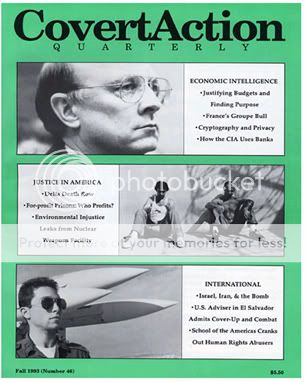
No.46 ( 1993) Economic intelligence; Israel & Iran; NSA; School of Amencas Ex-adviser reveals cover-up; Private prisons; Delta justice; Savannah River.
THIS IS ANOTHER MUST-READ, if you want to get the flavor of ECONOMIC INTELLIGENCE AND COUNTER-INTELLIGENCE.
For more on private prisons, see No. 3 at The top 3 unknown conspiracies of our time, at www.abovetopsecret.com...

No.46 ( 1993) Economic intelligence; Israel & Iran; NSA; School of Amencas Ex-adviser reveals cover-up; Private prisons; Delta justice; Savannah River.
THIS IS ANOTHER MUST-READ, if you want to get the flavor of ECONOMIC INTELLIGENCE AND COUNTER-INTELLIGENCE.
For more on private prisons, see No. 3 at The top 3 unknown conspiracies of our time, at www.abovetopsecret.com...
(46-of-76) COVERT ACTION QUARTERLY & the Holocaust(s) … see 1-of-76 for legend & relevance to Holocaust denial
Number 47 (Winter 1993-94)15th Anniversary: FBI vs. Bari; Russian October Coup; Rocky Flats Jury; NAFTA Trilateralists; Zinn on FBI, Dellinger on '908; Cold War Quiz; Ginsberg on CIA; Mumia Abu-Jamal; World Bank/lMF; Evergreen Air UN/CIA Proprietary.
Here’s some Cold War stuff on Ruskombank, the U.S.-Russia commercial bank that primarily ran the U.S.S.R. banking and technology connection … wasn’t it weird Russia always had the same modern technology as the U.S. did, as soon as the U.S. did? Dynastic traitors in the U.S. (running the U.S.) simply sold us out and transferred technology, money, and even U.S. printing plates.
ANTONY SUTTON
For his troubles not to mention his accurate and well-documented research, Antony was blackballed by the establishment in America, and feared for his life each day.
Number 47 (Winter 1993-94)15th Anniversary: FBI vs. Bari; Russian October Coup; Rocky Flats Jury; NAFTA Trilateralists; Zinn on FBI, Dellinger on '908; Cold War Quiz; Ginsberg on CIA; Mumia Abu-Jamal; World Bank/lMF; Evergreen Air UN/CIA Proprietary.
Here’s some Cold War stuff on Ruskombank, the U.S.-Russia commercial bank that primarily ran the U.S.S.R. banking and technology connection … wasn’t it weird Russia always had the same modern technology as the U.S. did, as soon as the U.S. did? Dynastic traitors in the U.S. (running the U.S.) simply sold us out and transferred technology, money, and even U.S. printing plates.
ANTONY SUTTON
For his troubles not to mention his accurate and well-documented research, Antony was blackballed by the establishment in America, and feared for his life each day.
During McCarthy era while Communists were persecuted in U.S., ruling family banking interests had well-established interlocking board members on Soviet Communist banks, and had been financing and issuing credit to the Communist, for 40 years.
I’m going to quote my book as an external source, [url=]americancivliancounter-terroristmanual.4t.com]
According to Antony Sutton, referring to ‘Skull & Bones Society’
Chevron Oil is Rockefeller owned. Chase Manhattan, a Rockefeller-owned bank plays both sides of the political fence. The extent of Chase collaboration with Nazis is staggering, and this was at a time when Nelson Rockefeller had an intelligence job in Washington aimed against Nazi operations in Latin America. Chase Bank in Paris was a Nazi collaborator. Chase Bank, later Chase Manhattan Bank, has been a prime promoter of exporting U.S. technology to the Soviet Union, far back as early 1920s.
The first war crafted and managed by the Order was the Spanish-American War. The second war crafted and created by the Group was the Anglo-Boer war of 1899. The rise of Hitler and Nazism in Germany, and the rise of the Marxist State in the Soviet Union, and the clash between these two powers and the political systems they represented was a major cause of World War II.
The Order financed revolutionary Marxism and its enemy Nazism to manage the nature and degree of the conflict to shape the evolution of the new World Order. The creation of the Soviet Union stems from the Order. The early survival of Soviet Union stems from the Order. Development of the Soviet Union stems from the Order. The Order created the Left and Right, Soviet Russia, and Hitler, to be the two global arms needed for managed conflict to synthesize the new World Order.
The arms were Guaranty Trust Co. of New York, and Brown Brothers, Harriman, private bankers of New York.
In 1984 Averell Harriman (The Order 1913) was elder statesman of Democratic party while George Bush (The Order 1949) was heading CIA, then running for vice president then president, head of moderate-extremist wing of Republican Party. Order created and financed Soviet Union. Order created and financed Nazi Germany.
Guaranty Trust Co., Brown Brothers, Harriman and Ruskombank developed Soviet Union’s oil and manganese. In 1901 the Caucasus oil fields … Baku fields … produced half the total world crude oil output. After the revolution, which was a coup d’état orchestrated against the Czar, Soviet Union needed raw materials, technical skills and working capital to restore Russian factories. American firm International Barnsdall Corp. provided equipment to the Communists.
They started drilling in the oil fields. International Barnsdall and Lucey Manufacturing Co. sent machinery and equipment from United States and sent American oil field workers to Communist Soviet Union. Chairman of International Barnsdall Corp. was Matthew C. Brush. Guaranty Trust, Lee Higginson & Co., and W. A. Harriman owned Barnsdall Corp. Barnsdall Corp. owned International Barnsdall Corp.
In 1913 Czarist Russia supplied 53 percent of world manganese, coming mostly from the Chiaturi deposits in the Caucasus. Production in 1920 was zero. The Soviets received modern mining and transportation facilities for their manganese deposits, acquired foreign exchange, and finally shattered American foreign policy concerning loans to the U.S.S.R. in a series of business agreements with W.A. Harriman Co. and Guaranty Trust.
Chairman of Georgian Manganese Co., the Harriman operating company on the site in Russia, was Matthew Crush (the Order 1913). While the Order carried out its plans to develop Russia, State Department was helpless, could do nothing.
In 1920s loans to Soviet Union were strictly against U.S. law. There were no diplomatic relations between United States and Soviet Union. There was no government support or government sanction for commercial activity between United States and Soviet Union. Government policy and public sentiment in the U.S. was against Soviet Union. But, Harriman-Guaranty cartel didn’t tell State Department of its plans. Averell Harriman sneaked an illegal project past the U.S. Government. He later became U.S. Ambassador to Russia.
Guaranty Trust, Union Banking Corp. were Harriman & Nazi interests that funded Hitler and helped construct and finance Nazism, National Socialism.
Meanwhile, the Order kept a hold on professional associations relating to Soviet Union. Anglo-Russian Chamber of Commerce was created in 1920 to promote trade with Russia. It was needed by Soviet Union to get the Czar’s industries working again. Chairman of the Executive Committee of Anglo-Russian Chamber Of Commerce was helped by Samuel R. Berton, a vice president of Guaranty Trust. The Order was aware that ‘issuing credits’ to U.S.S.R. was illegal. It wasn’t made legal until 1933 when President Roosevelt got elected.
(cont. from previous page)
Even though it was illegal and treason against the United States Government, Guaranty Trust did more than trade in Russian credits. Guaranty Trust made a joint banking agreement with the Soviets and installed a Guaranty Trust Vice President, Max May, as Director in Charge of the foreign division of a Soviet bank, the Ruskombank.
Meanwhile, the U.S. Government told U.S. citizens Soviet Communists were murderers. Meanwhile, the Department Of Justice was deporting ‘Reds’ back to Soviet Union. Meanwhile every American politician-lawyer was telling the American public the United States would have no relations with the Soviets.
But behind the scenes Guaranty Trust Co. was actually running a division of a Soviet bank. American troops were being cheered by Soviet revolutionaries for helping protect the ‘Revolution’. The Order’s law firm Simpson, Thatcher & Bartlett represented the Soviet State Bank in the U.S. In 1927 Simpson, Thatcher & Bartlett told U.S. Government, Soviets were starting to increase U.S. bank deposits.
This increase was priming the pump for huge payments to be directed to a few favored U.S. ruling family firms to build the Soviet First Five Year Plan. At the same time, in 1928, Secretary Kellogg said the government of the U.S. maintained the position it would be futile and unwise to enter into relations with Soviet Government. At this time the U.S., with implicit government approval, was involved in planning the First Five Year Plan in Russia. The planning work was done by American firms.
Order construction of the Soviet dialectic arm continued through the 1930s up to World War II. In 1941 W.A. Harriman was appointed Lend Lease Administrator to assure flow of U.S. technology and products to Soviet Union. Harriman violated Lend Lease law that required only military goods could be shipped to Soviet Union. He shipped vast amounts of industrial equipment.
Harriman shipped U.S. Treasury Department currency plates to Communist Russia. Now the Soviet Communists could freely print U.S. dollars.
(47-of-76) COVERT ACTION QUARTERLY & the Holocaust(s) … see 1-of-76 for legend & relevance to Holocaust denial
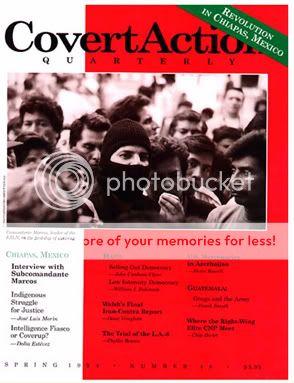
Number 48 (1994) Chiapas uprising; CIA and NAFTA; Haiti; Iran-Contra Report; L.A.-8; Mercenaries in Azerbaijan; Council for National Policy; Guatemala and drugs; Reader survey.

Number 48 (1994) Chiapas uprising; CIA and NAFTA; Haiti; Iran-Contra Report; L.A.-8; Mercenaries in Azerbaijan; Council for National Policy; Guatemala and drugs; Reader survey.
(48-of-76) COVERT ACTION QUARTERLY & the Holocaust(s) … see 1-of-76 for legend & relevance to Holocaust denial

Number 49 (1994) Montesinos and Fujimori; Sudan; Operation Gladio; Human testing; Armenia and Azerbaijan; South Africa’s left; El Salvador death squads.

Number 49 (1994) Montesinos and Fujimori; Sudan; Operation Gladio; Human testing; Armenia and Azerbaijan; South Africa’s left; El Salvador death squads.
(49-of-76) COVERT ACTION QUARTERLY & the Holocaust(s) … see 1-of-76 for legend & relevance to Holocaust denial
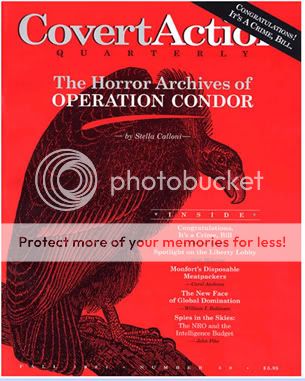
Number 50 (1994) Operation Condor; Clinton crime bill; Liberty lobby; Monfort meatpackers; Low intensity Democracy; NRO & intel. budget.

Number 50 (1994) Operation Condor; Clinton crime bill; Liberty lobby; Monfort meatpackers; Low intensity Democracy; NRO & intel. budget.
(50-of-76) COVERT ACTION QUARTERLY & the Holocaust(s) … see 1-of-76 for legend & relevance to Holocaust denial
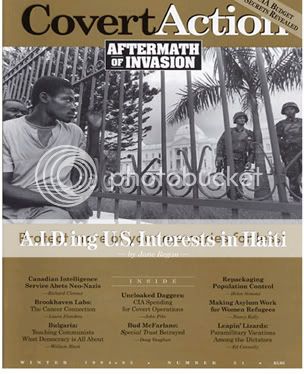
Number 5l (1994-95) U.S. in Haiti; Canadian intelligence abets Neo-Nazis; Brookhaven and cancer; Bulgaria; Population; Women’s asylum rights; CIA budget; Paramilitary vacations; Bud McFarlane.

Number 5l (1994-95) U.S. in Haiti; Canadian intelligence abets Neo-Nazis; Brookhaven and cancer; Bulgaria; Population; Women’s asylum rights; CIA budget; Paramilitary vacations; Bud McFarlane.
(51-of-76) COVERT ACTION QUARTERLY & the Holocaust(s) … see 1-of-76 for legend & relevance to Holocaust denial
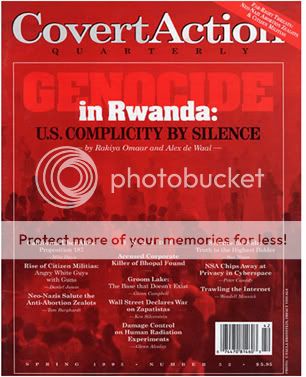
Number 52 (1995) Rwandan Genocide; Proposition 187; Rise of Militias; Neo Nazi Anti-Abortion Links; Groom Lake; Wall Street Pressures Mexico; Human Radiation Update; Corporations Fund Research; NSA in Cyberspace; Internet Resources; Warren Anderson located.
Rise of Militias; mediafilter.org...

Number 52 (1995) Rwandan Genocide; Proposition 187; Rise of Militias; Neo Nazi Anti-Abortion Links; Groom Lake; Wall Street Pressures Mexico; Human Radiation Update; Corporations Fund Research; NSA in Cyberspace; Internet Resources; Warren Anderson located.
Rise of Militias; mediafilter.org...
Winter is harsh in western Montana. Short days, bitter cold and heavy snows enforce the isolation of the small towns and lonely ranches scattered among the broad river valleys and high peaks of the Northern Rockies. But in February 1994 - the dead of winter - a wave of fear and paranoia strong enough to persuade Montanans to brave the, elements swept through the region. Hundreds of people poured into meetings in small towns to hear tales of mysterious black helicopters sighted throughout the United States and foreign military equipment moving via rail and flatbed truck across the country, in preparation for an invasion by a hostile federal government aided by U.N. troops seeking to impose a New World Order.
(51-of-76) cont.
Rwandan Genocide; mediafilter.org...
Rwandan Genocide; mediafilter.org...
In 1990, Rwandan exiles in neighboring Uganda formed the Rwandese Patriotic Front (RPF) and invaded, plunging the country into civil war and a vicious cycle of human rights abuse. By 1992, there had been several large-scale massacres, and political assassinations were commonplace. International investigations concluded that responsibility lay in the president's office. But in mid-1993, it seemed as though an internationally mediated peace agreement would bring the country back from the brink. The government, the RPF, and civil opposition parties (almost all of the latter Hutu-led) signed a set of Ac cords in Arusha, Tanzania, that appeared to provide a model for transition to democracy.
At another time, such bias might not have mattered as much. But when [U.S. Ambassador] Rawson arrived in December 1993, Rwandese politics rested on a knife edge. Four months earlier, the Habyarimana government, the rebel Rwandese Patriotic Front (RPF), and the civilian opposition parties had signed a comprehensive agreement in Arusha, Tanzania. It would have ensured a multi-party system, power-sharing with the main opposition groups, an independent judiciary with respect for human rights, integration of the RPF into the national army, and an abolition of the extremist paramilitary forces. This step toward peace and democracy was successfully negotiated with the apparent support of African and Western governments, and guaranteed by the troops of the U . N. Assistance Mission to Rwanda (UNAMIR). The U.S. government, under former Undersecretary of State for African Affairs Herman Cohen, had also put its weight behind the process that led to the Arusha agreement. But Habyarimana- under pressure from the extremists he had promoted to dominant positions in the army and government-repeatedly stalled in implementing the provisions of the accords. The extremists within the MRND and the CDR opposed the accords because they would have meant power-sharing and an end to their unfettered power and privilege.
U.S. Fiddles
While Rwanda Burns---
What followed was a carefully planned extermination. The government specially trained and mobilized its militia, the interahamwe, compiled in advance a list of targets, and dismissed all administrators seen as moderates, replacing them with extremists. The extremist Hutu radio RTLM and the state-sponsored Radio Rwanda broad cast calls inciting mass murder. Interim president, Theodore Sindikukwabo, also made incendiary speeches on radio and in person around the country congratulating the killers on a job well done and telling those in places such as Butare, where the killing had not yet started, that they should "set to work.".
The genocidal maniacs who ruled Rwanda chose an opportune moment to launch their "final solution." In April, powerful individuals in the U.S. government were actively rewriting the rules of international politics. They implemented changes that went beyond merely revising the ground rules for peacekeeping so that the dispatch of United Nations troops to the world's trouble spots would be almost impossible. They knowingly stood by while genocide occurred. By this inaction, they systematically began to unravel the great achievements of humanitarian law of this century--most of them gained in the period 1945-51 by men and women driven by the visceral shock of Auschwitz and Dresden. The genocide in Rwanda-one of the greatest crimes against humanity in the second half of the twentieth century-was an ironically opportune moment for these revisionists to stake their claim.
(52-of-76) COVERT ACTION QUARTERLY & the Holocaust(s) … see 1-of-76 for legend & relevance to Holocaust denial
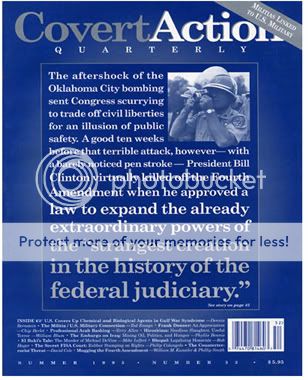
Number 53 (1995) Gulf War Syndrome Cover-Up; Militia and Military; Frank Donner; Arab Bashing; Hiroshima: Cold War Bomb; Iraqui Embargo; Guatemala: DeVine Murder; Bhopal; FISA Court; Omnibus Antiterrorism Act; Fourth Amendment Violation.
.
Gulf War Syndrome Cover-Up by Dennis Bernstein mediafilter.org...

Number 53 (1995) Gulf War Syndrome Cover-Up; Militia and Military; Frank Donner; Arab Bashing; Hiroshima: Cold War Bomb; Iraqui Embargo; Guatemala: DeVine Murder; Bhopal; FISA Court; Omnibus Antiterrorism Act; Fourth Amendment Violation.
.
Gulf War Syndrome Cover-Up by Dennis Bernstein mediafilter.org...
Pentagon denies that U.S. soldiers were exposed to chemical and biological warfare agents during the Gulf war, but its own records contradict the official line.
Spec. 1st Class Dean Lundholm, of the National Guard's 649th Military Police Company, was assigned to guard duty at the Hafar Al Batin POW camp near the Iraq-Kuwait border. He was in the shower when the Scud landed. Amid the wail of activated chemical warfare alarms, he dashed naked, holding his breath, through the open air to where his protective gear was stored. Soon after, he fell into a three-day coma. Now he is diagnosed as having Gulf War Syndrome.
Lundholm came home to a blaze of post-war hyperpatriotism and technophilia, as the allied powers gloated over among many other things their astoundingly low casualty figures. The number tossed around at the time was indeed minuscule: about 150 dead for the allies, contrasted against as many as 100,000 Iraqi corpses.
Yet now, four years after war's end, the euphoria seems premature. Tens of thousands of Gulf War personnel have come down with one or more of a number of disabling and life-threatening medical conditions collectively known as Gulf War Syndrome (GWS). The syndrome's cause is unclear, but veterans and researchers have focused on the elements of a toxic chemical soup in the war zone that includes insecticides, pesticides, various preventive medicines given experimentally to GIs, and smoke from the burning oilfields of Iraq and Kuwait.
There is also reliable evidence that one of its causes is exposure to low levels of chemical and biological warfare (CBW) agents during the war. According to a variety of sources, including just declassified Marine Corps battlefield Command Chronologies and After Action Reports, widespread exposure to CBW agents occurred when U.S.-led forces bombed Iraqi chemical facilities, and during direct attacks by the Iraqis.
And while numerous sources, including military documents, link GWS to those exposures, the U.S. defense establishment doesn't want to talk about it. Its policy of denial is making it substantially harder for Gulf War veterans to receive diagnoses that include all the probable toxins and their possible synergistic effects.
THE OFFICIAL LINE---
Despite mounting evidence, Pentagon denials continue. In sworn testimony before Congress in March, Dr. Stephen Joseph, Assistant Secretary of Defense for Health Affairs, stuck to the Department of Defense (DoD) position. There is no persuasive evidence of such exposures [to CBW agents], he said, even after much scrutiny. Joseph's comments echo those made last year by Defense Secretary William Perry and Joint Chiefs of Staff Chairman John Shalikashvili that there is no information classified or unclassified, that indicated chemical or biological weapons were used in the Persian Gulf.
[
More recently, former Dep. Sec. of Defense (and now newly confirmed Dir. of Central Intelligence) John Deutch, the DoD's point man on the Gulf War Syndrome, restated the government's line: [W]ith the help of an independent panel, [I] examined those instances where there are allegations of use or presence [of CBW agents], and it is my judgment at the present time that there has been no use or presence, but that judgment is amenable to change if further information comes up. Defense conclusion that chemical weapons were not used during the Gulf War. But former Senator Don Riegle (D-Mich.), whose Senate Banking Committee held extensive hearings and issued two reports on GWS, said the denials don't wash. According to Riegle, British and U.S. troops made at least 21 positive tests for the agents, and he accused the U.S. military of a cover-up
(53-of-76) COVERT ACTION QUARTERLY & the Holocaust(s) … see 1-of-76 for legend & relevance to Holocaust denial
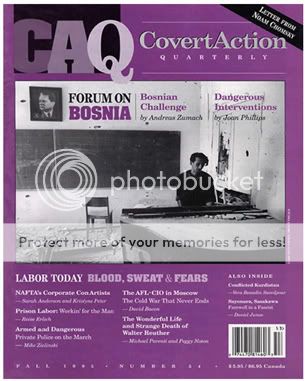
Number 54 (1995) Noam Chomsky on corporate propaganda; Bosnia; Kurdistan; Sasakawa obit; NAFTA layoffs; Prison labor; AFL-CIO in Russia; Private security guards; Walter Reuther.

Number 54 (1995) Noam Chomsky on corporate propaganda; Bosnia; Kurdistan; Sasakawa obit; NAFTA layoffs; Prison labor; AFL-CIO in Russia; Private security guards; Walter Reuther.
new topics
-
The Undertones - Teenage Kicks
Music: 24 minutes ago -
Volcano Watch 2025
Fragile Earth: 44 minutes ago -
Judge rules president-elect Donald Trump must be sentenced in 'hush money' trial
US Political Madness: 9 hours ago -
Farmers wife
Music: 10 hours ago -
NJ Drones tied to Tesla explosion at Trump Las vegas
General Conspiracies: 11 hours ago
top topics
-
Matthew Livelsberger said he was being followed by FBI
Political Conspiracies: 17 hours ago, 16 flags -
New Jersey-Teachers Can Now Be Certified Without Passing Basic Reading Writing Math Testing
Education and Media: 15 hours ago, 8 flags -
NJ Drones tied to Tesla explosion at Trump Las vegas
General Conspiracies: 11 hours ago, 6 flags -
Judge rules president-elect Donald Trump must be sentenced in 'hush money' trial
US Political Madness: 9 hours ago, 3 flags -
Farmers wife
Music: 10 hours ago, 2 flags -
Volcano Watch 2025
Fragile Earth: 44 minutes ago, 1 flags -
The Undertones - Teenage Kicks
Music: 24 minutes ago, 0 flags
active topics
-
Petition Calling for General Election at 564,016 and rising Fast
Political Issues • 220 • : Oldcarpy2 -
Paranoid Liberals Believe U.S. Service Members are More Dangerous than Illegal Aliens.
Social Issues and Civil Unrest • 36 • : Lazy88 -
NJ Drones tied to Tesla explosion at Trump Las vegas
General Conspiracies • 10 • : Athetos -
The Undertones - Teenage Kicks
Music • 0 • : gortex -
Judge rules president-elect Donald Trump must be sentenced in 'hush money' trial
US Political Madness • 6 • : Athetos -
Tesla Cybertruck Explodes in Front of Trump Hotel in Las Vegas
Mainstream News • 208 • : tjack -
Volcano Watch 2025
Fragile Earth • 0 • : Coelacanth55 -
Here we again... CHINA having mass outbreak of something
Diseases and Pandemics • 22 • : AdultMaleHumanUK -
Simulation theory and have we reset before like a game?
Conspiracies in Religions • 45 • : G1111B1234 -
Matthew Livelsberger said he was being followed by FBI
Political Conspiracies • 64 • : CarlLaFong
